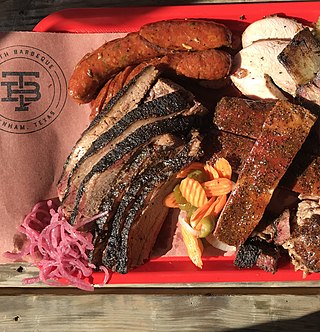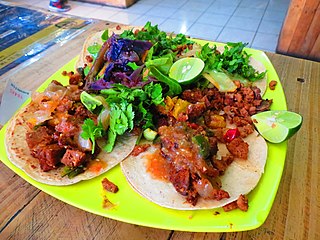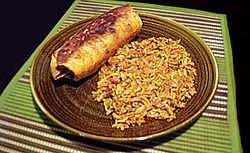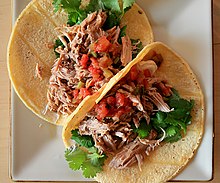
Mexican cuisine consists of the cooking cuisines and traditions of the modern country of Mexico. Its earliest roots lie in Mesoamerican cuisine. Its ingredients and methods begin with the first agricultural communities such as the Olmec and Maya who domesticated maize, created the standard process of nixtamalization, and established their foodways. Successive waves of other Mesoamerican groups brought with them their cooking methods. These included: the Teotihuacanos, Toltec, Huastec, Zapotec, Mixtec, Otomi, Purépecha, Totonac, Mazatec, Mazahua, and Nahua. With the Mexica formation of the multi-ethnic Triple Alliance, culinary foodways became infused.

In North America, a corn tortilla or just tortilla is a type of thin, unleavened flatbread, made from hominy, that is the whole kernels of maize treated with alkali to improve their nutrition in a process called nixtamalization. A simple dough made of ground, dried hominy, salt and water is then formed into flat discs and cooked on a very hot surface, generally an iron griddle called a comal.

Tostada is the name given to various dishes in Mexico and Guatemala which include a toasted tortilla as the main base of their preparation.

The cuisine of the Southwestern United States is food styled after the rustic cooking of the Southwestern United States. It comprises a fusion of recipes for things that might have been eaten by Spanish colonial settlers, cowboys, Native Americans, and Mexicans throughout the post-Columbian era; there is, however, a great diversity in this kind of cuisine throughout the Southwestern states.

A gordita in Mexican cuisine is a dish made with masa and stuffed with cheese, meat, or other fillings. It is similar to the Colombian and Venezuelan arepa. There are two main variations of this dish, one of which is typically fried in a deep wok-shaped comal, consumed mostly in central and southern Mexico, and another one baked on a regular comal. The most common and representative variation of this dish is the "gordita de chicharrón", filled with chicharron which is widely consumed throughout Mexico. Gorditas are often eaten as a lunch dish and accompanied by several types of sauce.

Huevos rancheros is a breakfast egg dish served in the style of the traditional large mid-morning fare on rural Mexican farms.

A wrap is a culinary dish made with a soft flatbread rolled around a filling.

New Mexican cuisine is the cuisine of the Southwestern US state of New Mexico. The region is primarily known for its fusion of Pueblo Native American cuisine with Hispano Spanish and Mexican cuisine originating in Nuevo México. This Southwestern culinary style is popular beyond the current boundaries of New Mexico, and is found throughout the old territories of Nuevo México and the New Mexico Territory, today the state of Arizona, parts of Texas, and the southern portions of Colorado, Utah, and Nevada.

Enchirito is the trademarked name of Taco Bell's menu item of the Tex-Mex food similar to an enchilada. It is composed of a flour tortilla filled with seasoned ground beef taco meat, beans, diced onions, cheddar cheese, and "red sauce".

Mexican street food, called antojitos, is prepared by street vendors and at small traditional markets in Mexico. Street foods include tacos, tamales, gorditas, quesadillas, empalmes, tostadas, chalupa, elote, tlayudas, cemita, pambazo, empanada, nachos, chilaquiles, fajitas, tortas, even hamburgers and hot dogs, as well as fresh fruits, vegetables, beverages and soups such as menudo, pozole and pancita. Most are available in the morning and the evening, as mid-afternoon is the time for the main formal meal of the day. Mexico has one of the most extensive street food cultures in Latin America, and Forbes named Mexico City as one of the foremost cities in the world in which to eat on the street.

A flour tortilla or wheat tortilla is a type of soft, thin flatbread made from finely ground wheat flour. Made with flour- and water-based dough, it is pressed and cooked, similar to corn tortillas. The simplest recipes use only flour, water, fat, and salt, but commercially-made flour tortillas generally contain chemical leavening agents such as baking powder, and other ingredients.

A burrito in Mexico is, historically, a regional name, among others, for what is known as a taco, a tortilla filled with food, in other parts of the country. The term burrito was regional, specifically from Guanajuato, Guerrero, Michoacán, San Luis Potosí and Sinaloa, for what is known as a taco in Mexico City and surrounding areas, and codzito in Yucatán and Quintana Roo. Due to the cultural influence of Mexico City, the term taco became the default, and the meaning of terms like burrito and codzito were forgotten, leading many people to create new meanings and folk histories. In modern times, it is considered by many as a different dish in Mexican and Tex-Mex cuisine that took form in Ciudad Juárez, consisting of a flour tortilla wrapped into a sealed cylindrical shape around various ingredients. In Central and Southern Mexico, burritos are still considered tacos, and are known as “tacos de harina”. The tortilla is sometimes lightly grilled or steamed to soften it, make it more pliable, and allow it to adhere to itself. Burritos are often eaten by hand, as their tight wrapping keeps the ingredients together. Burritos can also be served "wet", i.e., covered in a savory and spicy sauce, when they would be eaten with a fork and knife.

Queso flameado, also known as queso fundido or choriqueso, is a dish of hot melted cheese and spicy chorizo that is often served flambé. Often compared to cheese fondue, it is a party dish; it is popular at cookouts and in restaurants as an appetizer. Almost unique in Mexican cuisine, in the cuisine of the United States this dish has been widely adapted and is considered a native dish in El Paso. In Mexico, it occurs in restaurants more often in the north. Typical main ingredients are melted cheese and a characteristic meat sauce of loose fresh chorizo, tomato, onion, chile and spices. It is served in a small, shallow casserole or other ceramic or metal heat-proof baking dish. The cheese and sauce are prepared separately, and combined just before serving. This may be done at the table, especially if finished with a flambé: high alcohol liquor is poured on the cheese and ignited, and as it burns the server folds in the sauce. If not flambéed, the mixture may be quickly broiled. Either way, the finished dish is presented while it is still bubbling hot, and it is spooned onto small soft tortillas for individual servings.

Texan cuisine is the food associated with the Southern U.S. state of Texas, including its native Southwestern cuisine influenced Tex-Mex foods. Texas is a large state, and its cuisine has been influenced by a wide range of cultures, including Tejano/Mexican, Native American, Creole/Cajun, African-American, German, Czech, Southern and other European American groups. The cuisine of neighboring states also influences Texan cuisine, such as New Mexican cuisine and Louisiana Creole cuisine. This can be seen in the widespread usage of New Mexico chiles, Cayenne peppers, and Tabasco sauce in Texan cooking.

A tortilla is a thin, circular unleavened flatbread from Mesoamerica originally made from maize hominy meal, and now also from wheat flour.

Mexican-American cuisine is the cuisine of Mexican Americans and their descendants, who have modified Mexican cuisine under the influence of American culture and immigration patterns of Mexicans to the United States.



















